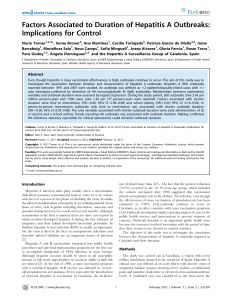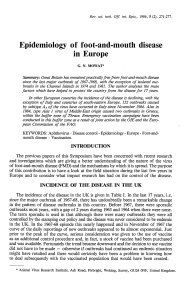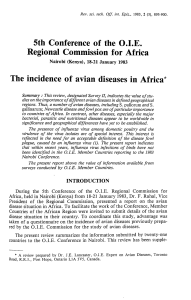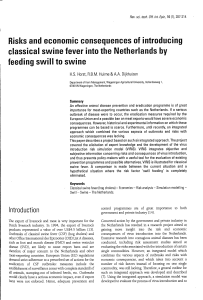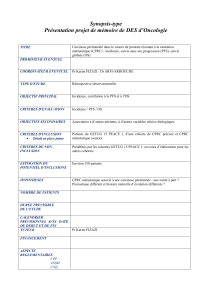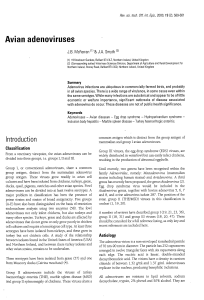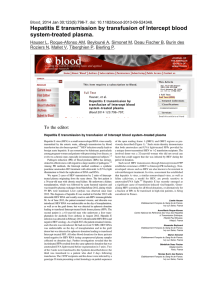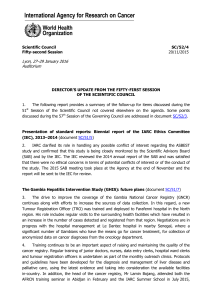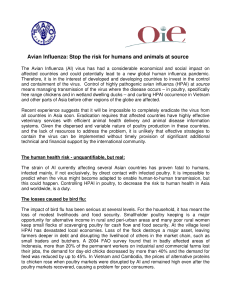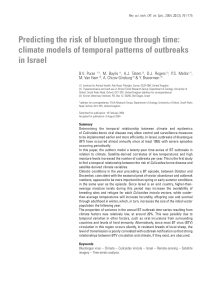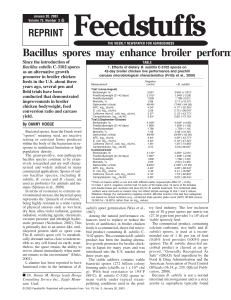D9087.PDF
publicité
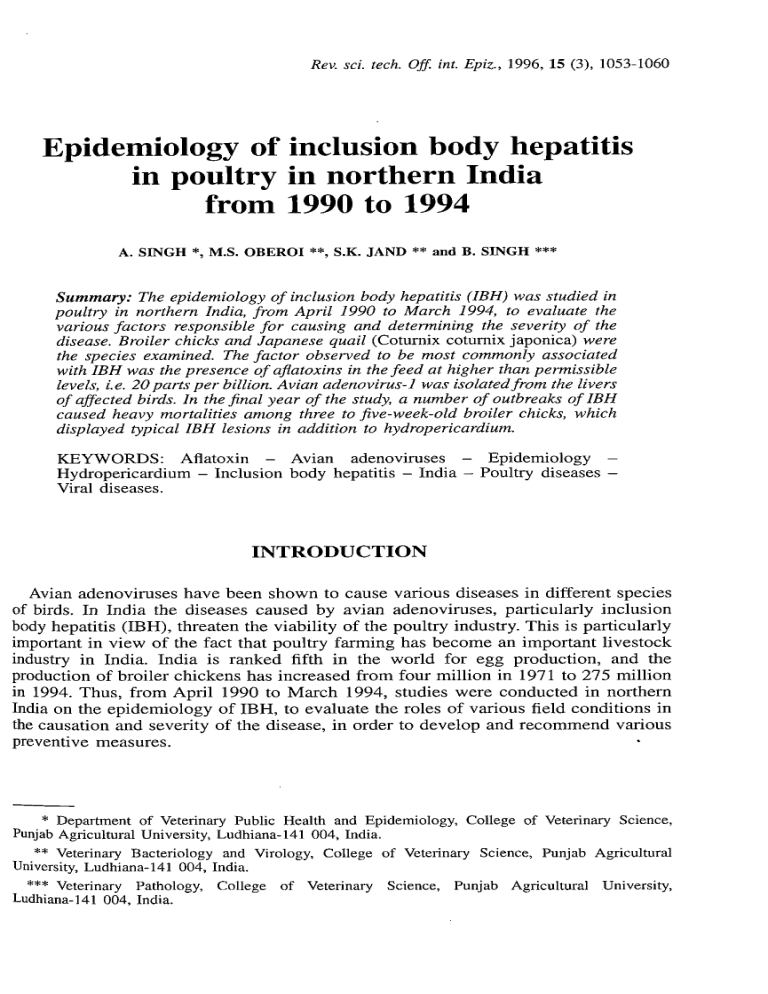
Rev. sci. tech. Off. int. Epiz., 1996, 15 (3), 1053-1060 Epidemiology of inclusion body hepatitis in poultry in northern India from 1990 to 1994 A. SINGH *, M.S. OBEROI **, S.K. JAND ** and B. SINGH *** Summary: The epidemiology of inclusion body hepatitis (IBH) was studied in poultry in northern India, from April 1990 to March 1994, to evaluate the various factors responsible for causing and determining the severity of the disease. Broiler chicks and Japanese quail (Coturnix coturnix japonica) were the species examined. The factor observed to be most commonly associated with IBH was the presence of aflatoxins in the feed at higher than permissible levels, i.e. 20 parts per billion. Avian adenovirus-1 was isolated from the livers of affected birds. In the final year of the study, a number of outbreaks of IBH caused heavy mortalities among three to five-week-old broiler chicks, which displayed typical IBH lesions in addition to hydropericardium. KEYWORDS: Aflatoxin - Avian adenoviruses - Epidemiology Hydropericardium - Inclusion body hepatitis - India - Poultry diseases Viral diseases. INTRODUCTION Avian adenoviruses have been shown to cause various diseases in different species of birds. In India the diseases caused by avian adenoviruses, particularly inclusion body hepatitis (IBH), threaten the viability of the poultry industry. This is particularly important in view of the fact that poultry farming has become an important livestock industry in India. India is ranked fifth in the world for egg production, and the production of broiler chickens has increased from four million in 1971 to 275 million in 1994. Thus, from April 1990 to March 1994, studies were conducted in northern India on the epidemiology of IBH, to evaluate the roles of various field conditions in the causation and severity of the disease, in order to develop and recommend various preventive measures. * Department of Veterinary Public Health and Epidemiology, College of Veterinary Science, Punjab Agricultural University, Ludhiana-141 004, India. ** Veterinary Bacteriology and Virology, College of Veterinary Science, Punjab Agricultural University, Ludhiana-141 004, India. *** Veterinary Pathology, Ludhiana-141 004, India. College of Veterinary Science, Punjab Agricultural University, 1054 MATERIALS AND METHODS Dead birds which had been brought for diagnosis were given detailed post-mortem examinations. Liver tissue was collected and processed for histopathological examination to confirm cases of IBH. Poultry farms with outbreaks of IBH were examined and a detailed record was made of management practices (floor space and feeding and watering conditions). Meteorological data for the region during the study period, i.e. the atmospheric temperature and relative humidity, were obtained from the Department of Agricultural Meteorology, Punjab Agricultural University, Ludhiana, India. Feed samples were collected from affected poultry farms and screened for the presence of aflatoxins (2, 17). When an outbreak of IBH was confirmed by histopathology, attempts were made to isolate the virus from the samples of liver tissue by using chicken-embryo liver (CEL) cell culture. The CEL cell culture was prepared from twelve-to-thirteen-day-old chicken embryos as per McFerran et al. (11). The trypsenised cell suspension of 1 X 10 cells/ml was seeded in Hank's balanced salt solution (HBSS) containing 10% calf serum. The maintenance medium consisted of 2 % calf serum. The infected CEL cell cultures were observed for six to seven days for any evidence of cytopathic effect (CPE). At the end of the incubation period, the cells were frozen and thawed three times, then harvested, along with the culture fluid, for further passage. Each sample was subjected to three blind passages, after which the culture fluid was tested by counterimmunoelectrophoresis (CIE) (14), dot enzyme-linked immunosorbent assay (ELISA) and double antibody sandwich ELISA (16) for the presence of avian adenovirus (AAV) group antigens. Serotyping was performed on ten isolates, using the microneutralisation test in a 96-well tissue culture plate as described by Grimes et al. (8). All the isolates were tested against standard AAV-1 rabbit serum. 6 RESULTS AND DISCUSSION During the study period, forty-seven outbreaks of IBH were confirmed by the presence of intranuclear inclusion bodies in hepatocytes. Table I summarises the epidemiological factors recorded for these outbreaks. IBH outbreaks occurred among broiler chicks of two to seven weeks of age. The largest number of outbreaks (40/47) occurred in the three-to-five-week age group. Earlier outbreaks of IBH have been recorded among broiler chicks of the same age group by a number of researchers (3, 6, 11, 15). Dhillon et al. demonstrated that serotypes of AAV were pathogenic for three-week-old specific-pathogen-free (SPF) chicks, which were inoculated intratracheally (4). The majority of IBH outbreaks within the study (26/47) were associated with mycotoxicosis (aflatoxicosis). The presence of anatoxin in the feed could be established in twenty outbreaks, with levels ranging from 200 parts per billion (ppb) to 1,000 ppb, both of which are well above the permissible level of 20 ppb. Other diseases diagnosed in these chicks, by necropsy and histopathology, were hydropericardium, infectious bursal disease, chronic respiratory disease, airsacculitis, rickets, coryza, coccidiosis, encephalomalacia and vitamin A deficiency. These diseases appeared either alone or (in seventeen outbreaks) in combination with IBH. 1055 TABLE I Epidemiological factors recorded in histopathologically confirmed outbreaks of inclusion body hepatitis from 1990 to 1994 Year No. of confirmed outbreaks Age Space/bird Mortality Anatoxins Virus Flock size of birds (sq. ft.) (% age) in feed * isolated ** (weeks) 1990-1991 10 500-13,000 2-5 0.3-0.8 3.3-20.0 5/7 10/10 1991-1992 10 500-10,000 2-7 0.4-2.5 0.43-17.5 2/3 8/10 1992-1993 8 400-3,000 2-6 0.5-1.8 0.26-12.5 4/7 5/7 19 850-40,000 3-5 0.4-1.6 0.75-21.0 9/10 8/19 1993-1994 * Nominator: number of outbreaks in which feed samples tested positive for anatoxins with a range of 200 parts per billion (ppb) to 1,000 ppb. Denominator: number of outbreaks from which feed samples were processed ** Nominator: number of outbreaks which yielded avian adenovirus (AAV). Denominator: number of outbreaks from which isolation of AAV was attempted Mortality in the IBH-affected flocks varied from 0.26% to 2 1 % with an average of 5.77 ± 0.86. The average mortality rate in an outbreak of IBH, where there was no other concurrent disease, was 3.34 ± 1.35. However, the average mortality rate of an outbreak of IBH associated with aflatoxicosis was 6.58 ± 1.37. When IBH was associated with a disease other than aflatoxicosis, the mortality rate was 4.51 ± 1.78. In IBH outbreaks where aflatoxicosis was found in conjunction with another disease, the mortality rate was 8.08 ± 2.26. It is evident that aflatoxicosis and other diseases play a major role in increasing the mortality rate of an IBH outbreak. The observations of this study have been substantiated by other experimental studies of broiler chicks, which also suggest that the presence of the aflatoxin B in feedstuffs is a significant risk factor for an outbreak of IBH, caused by AAV-1 (20). Moreover, Jand et al. have also recently found a close association between aflatoxins in feed and the occurrence of IBH (9). Because aflatoxins not only damage the liver but also suppress the immune system, chicks are more likely to suffer from other concurrent diseases, resulting in a higher mortality (5). 1 Table II shows the monthly incidence of IBH outbreaks alongside the mean temperature and relative humidity for each month. Most outbreaks (27/47) were recorded during the months of October, November and December. There is a clear correlation between the high number of outbreaks during these months and the high temperatures and relative humidities of the preceding two months, August and September, which provided suitable conditions for the growth of toxin-producing moulds in the feed ingredients ( 1 , 18). Such feed ingredients are usually fed to the chicks during subsequent months (i.e., October to December), resulting in a predisposition to IBH. Furthermore, it was found that, in the majority of outbreaks which had a mortality rate of more than 10%, the birds were provided with less space than normal (one square foot per bird), in addition to less space for watering and feeding (Table I). This would indicate that over-intensive husbandry practices and poor management also predisposed the birds to higher mortalities. 1056 TABLE I I Consolidated data of monthly incidence of confirmed outbreaks of inclusion body hepatitis and meteorological data from 1990 to 1994 No. of outbreaks Mean atmospheric temperature (°C) Relative humidity April 2 24.85 49.3 May 2 31.10 40.7 June 1 32.03 51.6 July 4 30.14 72.4 August 0 29.64 77.4 September 3 28.52 73.2 October 8 23.88 59.1 November 10 18.88 63.3 December 9 13.85 72.0 January 1 12.56 76.0 February 3 14.73 72.8 March 4 18.74 64.7 Month Total (%) 47 Avian adenovirus was isolated from the tissues of chicks involved in thirty-one outbreaks. The isolates showed cytopathic effects with evidence of intranuclear inclusion bodies in the cell culture. The presence of AAV in all the isolates was confirmed by positive reactions from CIE, dot ELISA and double antibody sandwich ELISA tests. Grewal et al. and Nagal et al. have also reported the isolation of AAV from cases of IBH in this region (6, 12). The results of titration and virus neutralisation of ten isolates and standard AAV-1 (chicken embryo lethal orphan: CELO) with 1:50 dilution of standard type-1 rabbit serum are shown in Table III. There was a decrease of more than four-fold in the titres of all ten isolates and the standard strain. The serotyping of these isolates indicates that they were all neutralised with standard type-1 rabbit serum, in turn indicating that these isolates were all AAV-1 (CELO) type. The isolates of Grewal et al. and Nagal et al. were also found to be closely related to AAV-1 (6, 13). AAV-1 was also found to play a major role in the IBH-hydropericardium syndrome observed in the broiler chicks. During the study period, four outbreaks of IBHhydropericardium syndrome were recorded from July 1993 onwards. AAV-1 was isolated from three of these outbreaks. The rate of mortality in these outbreaks varied from 12.5% to 2 1 % . Since IBH-hydropericardium syndrome is proving very damaging to the poultry industry in India, further work is being done in order to determine the parts played by various aetiological agents, and to find suitable preventive measures. To this end, experimental trials in broiler chicks with a live AAV-1 (IBH isolate) virus vaccine have yielded encouraging results, according to virus neutralisation and challenge tests (10). 1057 TABLE III Results of microneutralisation test of avian adenovirus (AAV) isolates with standard AAV type-1 antibody Log values of 10 Serial No. Isolate No. 1 Standard CELO virus 4935 4944 5088 5091 10897 12883 12996 13901 14295 14522 2 3 4 5 6 7 8 9 10 11 Virus titre (VT) Serum-virus titre (ST) Neutralisation index (VT-ST) 7.5 0 7.5 7.5 7.0 7.3 7.0 5.5 7.3 6.5 5.5 5.6 7.5 0 2.5 1.0 1.5 0 0 2.0 1.5 0 2.5 7.5 4.5 6.3 5.5 5.5 7.3 4.5 4.0 5.6 5.0 CELO: chicken embryo lethal orphan In December 1991, an outbreak of IBH was recorded in ten-week-old Japanese quail (Coturnix coturnix japonica), which experienced a heavy mortality rate (57.25%), due to necrotic hepatitis, characterised by the presence of large basophilic intranuclear inclusion bodies in hepatocytes. AAV-1 was isolated from the livers of these birds (7). During experimental transmission studies, this isolate reproduced IBH in broiler chicks and Japanese quail of more than three weeks of age (19). The conclusion of this present study, which spanned more than four years, is that IBH in broilers is primarily caused by AAV-1 and is accompanied by a low degree of mortality. However, the mortality range, as well as the number of outbreaks, increases when the feed has more than the permissible levels of aflatoxin. The mortality becomes even greater when other diseases are concurrent. ACKNOWLEDGEMENTS This research has been financed by a grant made by the United States of Agriculture under the Co-operative Agricultural Research Grant (PL-480). Thanks are also due to P.W. Chang, Department of Fisheries, Veterinary Science, University of Rhode Island, Kingston, United States who kindly supplied the AAV-1 rabbit serum. * * * Department Programme Animal and of America, 1058 ÉPIDÉMIOLOGIE DE L'HÉPATITE À CORPS D'INCLUSION DES VOLAILLES DANS LE NORD DE L'INDE DE 1990 À 1994. - A. Singh, M.S. Oberoi, S.K. Jand et B. Singh. Résumé : Une étude sur l'épidémiologie de l'hépatite à corps d'inclusion des volailles (inclusion body hepatitis ou IBH) a été conduite dans le nord de l'Inde, d'avril 1990 à mars 1994, afin d'évaluer les différents facteurs responsables de la maladie et de sa gravité. L'étude a porté sur les poulets de chair et les cailles domestiques (Coturnix coturnix japonica). Le facteur le plus couramment associé à l'IBH était la présence d'aflatoxines dans l'alimentation à des niveaux supérieurs au seuil autorisé, soit 20 parties par milliard. L'adénovirus-1 aviaire a été isolé à partir du foie des volailles atteintes. Pendant la dernière année de l'étude, plusieurs foyers d'IBH ont entraîné une forte mortalité chez les poulets de chair de trois à cinq semaines, qui présentaient, outre un hydropéricarde, des lésions caractéristiques de l'IBH. MOTS-CLÉS : Adénoviras aviaires - Aflatoxines - Epidémiologie Hépatite à corps d'inclusion - Hydropéricarde - Inde - Maladies aviaires Maladies virales. * * * EPIDEMIOLOGÍA DE LA HEPATITIS POR CUERPOS DE INCLUSIÓN EN AVES DE CORRAL DEL NORTE DE LA INDIA, ENTRE 1990 Y 1994. - A. Singh, M.S. Oberoi, S.K. Jand y B. Singh. t Resumen: Entre abril de 1990 y marzo de 1994 se llevó a cabo, en el norte de la India, un estudio sobre la epidemiología de la hepatitis por cuerpos de inclusión (inclusion body hepatitis: IBH) en aves de corral. Su propósito era evaluar el papel desempeñado por diversas variables en tanto que causas o factores determinantes de la gravedad de la enfermedad. Dos fueron las especies examinadas: el pollo de asar (broiler) y la codorniz japonesa (Coturnix coturnix japonica). Pudo observarse que el factor asociado con mayor frecuencia a la IBH era la presencia de aflatoxinas en la dieta de los animales en cantidades superiores al nivel permisible, es decir 20 partes por billón. En muestras de hígado de las aves afectadas se aisló adenovirus aviar-1. En el último año del estudio, varios brotes de IBH causaron severa mortandad entre los pollos de tres a cinco semanas de edad. Dichos ejemplares exhibían lesiones características de la IBH, además de hidropericardio. PALABRAS CLAVE: Adenovirus aviares - Aflatoxina - Enfermedades de las aves de corral - Enfermedades víricas - Epidemiología - Hepatitis por cuerpos de inclusión - Hidropericardio - India. * * * 1059 REFERENCES 1. BALARAMAN N. & GUPTA H . K . ( 1 9 9 0 ) . - Occurrence of aflatoxin in the livestock feeds of Sikkim. Indian J. Anim. Nutr., 7, 1 4 3 - 1 4 6 . 2. BARBALOCK R., COLBURN C.R. & SMITH R.J. ( 1 9 7 4 ) . - Rapid screening method for examining corn and corn derived products for possible anatoxin contamination. J. Assoc. official anal. Chemists, 57, 7 6 4 - 7 6 6 . 3. CHRISTENSEN N . H . & SAIFUDDIN M.D. ( 1 9 8 9 ) . - A primary epidemic of inclusion body hepatitis in broilers. Avian Dis., 33, 6 2 2 - 6 3 0 . 4. DHILLON A.S., WINTERFIELD R.W., THACKER H . L . & FELDMAN D.S. ( 1 9 8 2 ) . - Lesions induced in the respiratory tract of chickens by serologically different adenoviruses. Avian Dis., 26, 4 7 8 - 4 8 6 . 5. GIAMBRONE J.J., EWERT D.J., WYATT R.D. & EIDSON C.S. ( 1 9 7 8 ) . - Effect of aflatoxin on the humoral and cell-mediated immune systems of the chicken. Am. J. vet. Res., 39, 305-307. 6. GREWAL G.S., SHARMA S.N. & DEKA B . C . ( 1 9 8 1 ) . - Inclusion body hepatitis in broiler chickens. Indian J. poult. Sci., 16, 5 1 - 5 6 . 7. GREWAL G.S., SINGH A., SINGH B . & OBEROI M.S. ( 1 9 9 4 ) . - Inclusion body hepatitis in Japanese quail (Coturnix coturnix japonica). Indian J. Anim. Sci., 64, 6 6 5 - 6 6 7 . 8. GRIMES T.M., KING D.J. & KLEVEN S.H. ( 1 9 7 6 ) . - Application of a microtiter cell-culture method to characterization of avian adenoviruses. Avian Dis., 20, 2 9 9 - 3 1 0 . 9. JAND S.K., SINGH RR & SINGH A. ( 1 9 9 5 ) . - Observations on occurrence of poultry diseases associated with mycotoxins in feed. Indian J. Anim. Sci., 65 ( 1 0 ) , 1 0 6 3 - 1 0 6 7 . 10. KAUR A., OBEROI M.S. & SINGH A. ( 1 9 9 4 ) . - Evaluation of inclusion body hepatitis virus (avian adenovirus) vaccines in broilers. In National symposium on recent advances in production and testing of veterinary biologicals, 2 9 - 3 1 January. Indian Association of Veterinary Microbiologists, Immunologists and Specialists in Infectious Diseases (IAVMI). IAVMI, Pune, India, 5 3 pp. 11. MCFERRAN J.B., MCCRACKEN R.M., CONNOR T.J. & EVANS R.T. ( 1 9 7 6 ) . - Isolation of viruses from clinical outbreaks of inclusion body hepatitis. Avian Pathol., 5, 3 1 5 - 3 2 4 . 12. NAGAL K . B . , MAITI N.K., OBEROI M.S. & SHARMA S.N. ( 1 9 9 0 ) . - Antigenic characterisation of fowl adenovirus strain by neutralisation test and dot-ELISA. Indian J. Anim. Sci., 60, 1 0 2 3 - 1 0 2 6 . 13. NAGAL K . B . , MAITI N.K., OBEROI M.S. & SHARMA S.N. ( 1 9 9 0 ) . - Isolation and characterization of avian adenovirus from cases of inclusion body hepatitis in broilers. Arch. vet. Bucuresti, 19, 8 3 - 8 6 . 14. OBEROI M.S., SHARMA S.N. & MAITI N . K . ( 1 9 9 0 ) . - Detection of avian adenovirus by counterimmunoelectrophoresis. Indian J. Anim. Sci., 60, 1 3 0 7 - 1 3 0 8 . 15. REECE R.L., BARR D.A., GRIX D . C , FORSYTH W.M., CONDRON R.J. & HINDMARSH M. (1986). - Observations on naturally occurring inclusion body hepatitis in Victorian chickens. Aust. vet. J., 63, 2 0 1 - 2 0 2 . 16. SAIFUDDIN M.D. & WILKS C.R. (1990). - Development of an enzyme-linked immunosorbent assay to detect and quantify adenovirus in chicken tissues. Avian Dis., 34, 2 3 9 - 2 4 5 . 1060 17. SASHIDHAR R.B., BHAT R.V. & VASANTHI S. (1989). - Rapid detection of aflatoxin by pressure mini-column technique: a collaborative trial. Curr. Sci., 58, 882-885. 18. SELVASUBRAMANIAN S., CHANDRASEKARAN D., VISHWANATHAN K., BALACHANDRAN C , PUNNIAMURTHY N . & VEERAPANDIAN C . (1987). - Surveillance of aflatoxin B , in various livestock and poultry feeds. Indian vet. J., 64, 1033-1034. 19. SINGH A., OBEROI M.S. & SINGH B . (1995). - Pathogenicity of quail's inclusion body hepatitis virus (avian adenovirus-1) for Japanese quails and broiler chicks. Vet. Res. Comm., 19 (6), 545-551. 20. SINGH H. (1991). - Studies on the pathology of aflatoxin toxicity, inclusion body hepatitis and their interactions in poultry. MVSc thesis, Punjab Agricultural University, Ludhiana, India, 179 pp.
